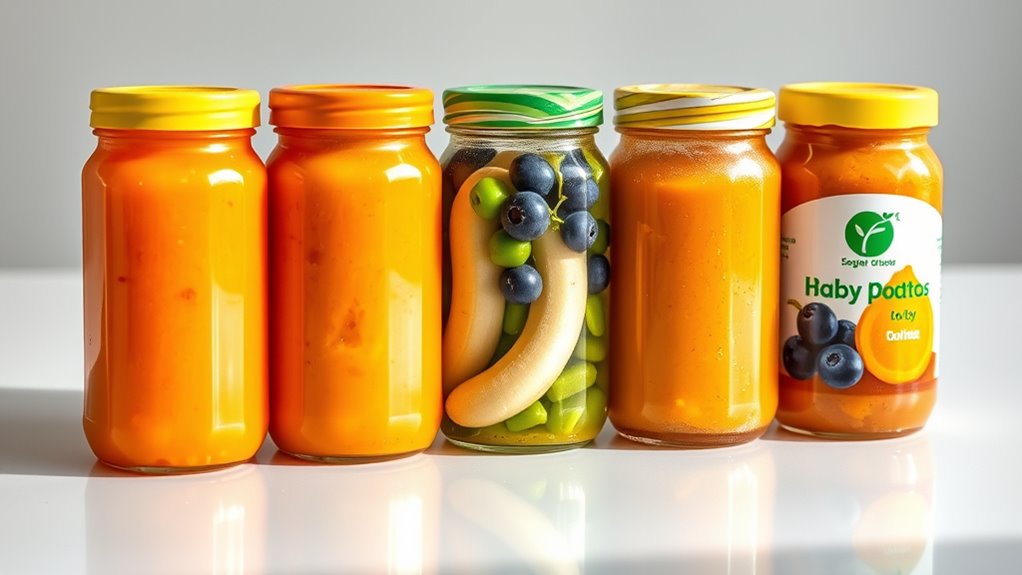Many baby foods marketed as healthy are hidden sugar bombs. They often contain added sweeteners like fruit juice concentrate, honey, or agave syrup, even if labels say otherwise. Concentrated purees and fruit-based snacks can disguise high sugar content, impacting your child’s health. By checking ingredient lists carefully, you can avoid these sneaky sugars. If you want to uncover which foods are truly healthy, stay tuned for more tips.
Key Takeaways
- Many baby foods labeled as healthy contain hidden added sugars like fruit concentrates or sweeteners such as honey.
- Products marketed as organic or natural often still include concealed sugars that boost sweetness.
- Ingredient lists with terms like “fruit juice concentrate” or “mango nectar” indicate hidden added sugars.
- Natural sweeteners like honey or agave are commonly used to disguise extra sugar content in baby foods.
- Reading nutrition labels carefully can help identify hidden sugars and prevent feeding unnecessary sweetness to infants.

Many processed foods and beverages secretly pack more sugar than you realize, turning everyday items into hidden sugar bombs. This is especially true when it comes to baby foods, which often appear healthy but can contain surprising amounts of added sugars. Even products marketed as “natural” or “healthy” may include hidden additives—ingredients that aren’t immediately obvious but considerably contribute to your child’s sugar intake. It’s easy to assume that certain foods are safe choices because they’re labeled as organic or free from artificial flavors, yet manufacturers frequently use natural sweeteners to enhance flavor without making it obvious. These natural sweeteners, like honey or agave syrup, get masked within ingredients lists, making it harder to track just how much sugar your baby is consuming.
Many parents trust that baby foods are designed to promote healthy growth, but that trust can be misplaced if you don’t scrutinize labels carefully. For example, fruit-based purees or snacks may seem like healthy options, but they often contain added sugars, either directly or through hidden additives that serve as natural sweeteners. These added sugars can spike blood sugar levels and contribute to a preference for overly sweet foods later in life. Because manufacturers are adept at disguising these sweeteners, it’s crucial to become familiar with ingredient lists and understand that terms like “fruit concentrate” or “mango nectar” can indicate added sugars. Even seemingly innocent ingredients like fruit purees can be concentrated, which naturally boosts sugar content, but sometimes they are supplemented with extra sweeteners.
Many fruit purees may be concentrated or contain hidden added sugars, impacting your child’s health.
Furthermore, many baby foods are formulated to appeal to a child’s palate by adding subtle amounts of natural sweeteners to enhance taste without raising suspicion. Unfortunately, this means that what seems like a wholesome choice might actually be a cleverly disguised sugar source. These hidden additives are often used to improve flavor and texture, making the food more appealing but also increasing the overall sugar content. As a parent, you should be cautious and always check nutrition labels carefully. Avoid products with ingredient lists that include terms like “honey,” “maple syrup,” or “fruit juice concentrate,” which are all forms of natural sweeteners that add sugar but aren’t always clearly labeled on the front of the packaging.
Awareness of how natural sweeteners are used in baby foods can help prevent unintended excessive sugar consumption. In the end, understanding that many baby foods contain hidden sugars and additives can help you make smarter choices. Focus on whole, unprocessed options whenever possible, and don’t be fooled by labels that emphasize “natural” without transparency. Your vigilance can protect your child from consuming unnecessary sugar, setting the stage for healthier eating habits in the future. Recognizing these hidden sugar sources—and the subtle ways natural sweeteners are incorporated—allows you to keep your baby’s diet as wholesome as possible.
Frequently Asked Questions
Are Organic Baby Foods Less Likely to Contain Hidden Sugars?
You might wonder if organic baby foods are less likely to contain hidden sugars. While organic labels suggest fewer artificial ingredients, they don’t guarantee low sugar content. Always check the nutrition label for sugar detection, as some organic products may still have added sugars or natural sugars that add up quickly. Being vigilant helps make certain your baby gets the healthiest options without unexpected sugar intake.
How Can I Identify Hidden Sugars on Ingredient Labels?
Imagine reading a story, but the words hide surprises. When you look at ingredient labels, you’re sleuthing for sugar detection. To spot hidden sugars, check for terms ending in “-ose,” like glucose or fructose, and look beyond “sugar” itself. Be vigilant—ingredients are listed by weight, so the first few are most prominent. With sharp eyes, you can uncover sneaky sugars lurking in your baby’s foods.
Do Natural Sweeteners Also Contribute to Hidden Sugar Content?
Natural sweeteners, like honey or maple syrup, can also contribute to hidden sugar content in foods. While they’re often seen as healthier sugar alternatives, they still contain natural sugars that add to your intake. When you read labels, check for these natural sweeteners, as they can be listed under different names. Being aware of all sugar sources helps you make better choices, especially for your baby’s nutrition.
What Are the Long-Term Health Effects of Hidden Sugars in Baby Foods?
Think of hidden sugars as sneak thieves, quietly building a storm inside your child’s tiny body. Over time, they can set the stage for metabolic syndrome and increase the risk of dental cavities. These sweet saboteurs may seem harmless initially, but their long-term effects can weigh heavily on health, leading to issues that ripple through years. Being vigilant about sugar in baby foods helps protect your child’s bright, healthy future.
Are There Specific Brands Known for Lower Sugar Baby Food Options?
You’ll want to look for brands that prioritize transparency and clear sugar content labeling, making it easier to choose healthier options. Some brands are known for offering lower sugar baby foods, often explicitly stating their commitment to minimal added sugars on their packaging. By paying attention to labels and selecting brands that are transparent about ingredients, you can better guarantee your baby’s food is nutritious and free from hidden sugars.
Conclusion
Now that you know these hidden sugar bombs, you can make smarter choices for your little one. Imagine reading labels without the shock of unexpected sugars sneaking in—it’s easier than you think. Don’t let the bright packaging fool you; behind the scenes, many baby foods hide sweetness that can impact your child’s health. By staying vigilant, you guarantee your baby gets nourishing, wholesome options, giving them the best start without the surprise of hidden sugars.










